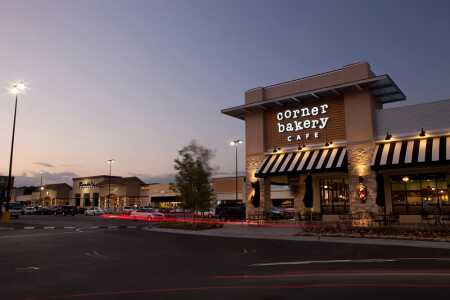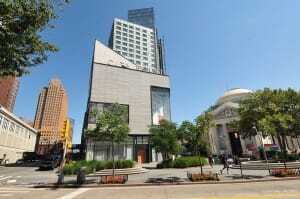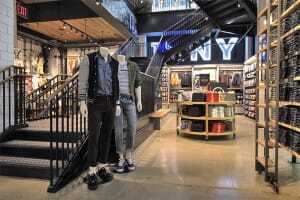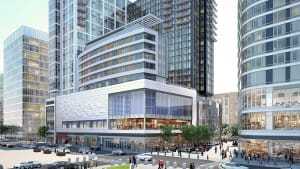
Older retail properties across the United States are getting facelifts, including Chevy Chase Pavilion, a 155,000-square-foot (14,000 sq m) center in Washington, D.C., that was renovated in 2013. Owned by Clarion Partners on behalf of a real estate investment fund, Chevy Chase Pavilion is anchored by H&M, Old Navy, and Range. (Clarion Partners)
The growing economic impact of millennials, growing demand for dining, and increasing interest from international brands are transforming the American retail real estate landscape.
“The lifestyle choices of millennials are greatly affecting retail development today,” says Ron Pastore, senior retail specialist and a director at Boston-based AEW Capital Management.
“The shopping center is a product of suburbanization and the automobile—two things which are not in vogue with millennials. New urban retail development, particularly infill locations where people can live/work/play, are more sought after.”
U.S. consumers are benefiting from solid job growth and falling unemployment, which in turn are powering new retail construction, says Mark Zandi, chief economist of Moody’s Analytics and cofounder of Economy.com. “The outlook for U.S. retail real estate is very good over the next two to three years,” he says. “Stronger wage gains will also lift consumer confidence and spending. Lower gasoline prices are also a big plus. That, in turn, will help real estate development.”
Growing demand for space from brands already established in Europe and Asia is also fueling retail development, says Christopher M. Conlon, executive vice president and chief operating officer of Acadia Realty a self-managed equity real estate investment trust (REIT) based in Rye, New York.
“EXKi, an upscale fast-casual restaurant from Belgium, and global coffee house Caffebene of South Korea have recently opened stores here in the United States,” Conlon notes. Belgium’s Le Pain Quotidien has been successful in the United States and is seeking to open more stores, he says. Pret A Manger of the United Kingdom wants to increase its footprint in New York and already has expanded to several areas, including Washington, D.C.
Despite all the worries about the impact of internet retailing, bricks-and-mortar stores are far from passé, particularly for the market segment most sought after by retailers—millennials.

AEW Capital Management, which manages over 10 million square feet (930,000 sq m) of retail property in the United States, renovated Houston’s Woodlake Square, a 180,000-square-foot (17,000 sq m) community center, in 2013. Anchors at Woodland Square, which was located on an A-plus site with a Class B configuration, include Randall’s Supermarket, Corner Bakery, and Jos. A. Bank. (Radkey Jolink)
According to a 2014 study by Chicago-based OpinionLab, a research firm that collects and analyzes customer feedback, individuals who reached adulthood around the turn of the 21st century prefer visiting the mall to shopping online: over one-third (37 percent) of millennials picked the mall as their favorite place to shop, followed by online (27 percent). Whereas a growing number of sales are completed online (e-commerce accounted for 7 percent of total retail sales in the first quarter of 2015, up from 6.2 percent a year earlier, the U.S. Department of Commerce reported in August), actual stores, where the majority of transactions occur, are still frequented by the members of the 80 million–strong millennial generation.

In downtown Brooklyn, New York, Acadia Realty Trust and Washington Square Partners are developing City Point, a 1.9 million-square-foot (177,000 sq m) mixed-use development scheduled for completion in 2016 and including retail, residential, entertainment, and office uses. Its 675,000 square feet (63,000 sq m) of commercial space will include a Century 21 department store, Target, Trader Joe’s, and Alamo Drafthouse Cinema, and a 26,000-square-foot (2,400 sq m) food hall occupied by 40 or more companies. (Acadia Realty Trust)
Retail businesses today must engage the shopper: millennials and others are attracted to diverse, amenity-rich urban environments that are walkable, social, and close to where they live and work, says David P. Manfredi, principal at Elkus Manfredi Architects in Boston.
“These are most typically precincts and neighborhoods in cities where shops and restaurants are proximate to housing, workplaces, education, and entertainment,” says Manfredi. “They are part of the fabric of the city, are authentic, diverse, and they provide places for social interaction that are not just about sales.”
Elkus Manfredi collaborated with Caruso Affiliated on the Grove in Los Angeles and Americana at Brand in Glendale, California—places where shops and restaurants are connected to the public realm. “The edges are blurred,” he says. “At Seaport Square in Boston, we are designing two blocks of retail that include 250,000 square feet [23,000 sq m] of shops, restaurants, cinema, and entertainment, as well as over 800 multifamily units. The retail boundaries are becoming less defined and the shopping trip is less planned.”
Shoppers today seek compelling customer engagement, agrees David Schwing of San Francisco’s BAR Architects. “In-store customer amenities, social interaction, personalized customer service, entertainment, and special products are features that the internet experience cannot provide and that consumers enjoy and often prefer,” Schwing says.
BAR Architects is designing two new mixed-use developments in San Francisco—Candlestick Point and 901 16th Street—that include residential and ground-floor retail space.
Boutique Focus

Architecture firm Cooper Carry is working on the repositioning of Simon Property Group’s Phipps Plaza, a retail landmark in Atlanta’s Buckhead neighborhood. The firm has completed an interior renovation of the mall—anchored by Saks Fifth Avenue, Nordstrom, and Belk—and is now designing an AC by Marriott hotel for the site. (Cooper Carry)
“Small retail, boutique, or hybrid businesses can feature unique and local products not offered by larger, national retailers,” says Susan McComb, a principal with BAR Architects. “National retailers are refining and tailoring their concepts to fit in smaller formats in urban locations. Many businesses, such as Target, are attempting to present a more granular, local character with adapted concepts targeting the urban demographic.”
Urban development and expansion of existing properties are driving retail building today, says Garrick Brown, vice president of research, west region, for national brokerage firm Cushman & Wakefield.
“At the close of the 2015 third quarter, we were tracking 31.7 million square feet [2.9 million sq m] of new shopping space under construction,” says Brown. “That number was at roughly 21 million square feet [2 million sq m] just six months ago.
“About 70 percent of this development spurt is expansions or new wings being added to existing centers; not much of it is in the form of brand-new shopping centers. Retail development follows rooftops, but most of the new rooftops are urban, so it makes sense that about 60 percent of retail development is in denser urban areas as opposed to suburban or rural markets.”
Fueling the U.S. retail development engine is strong job growth—some 200,000 new jobs every month—and robust household formulation, says Chris Roscoe, head of retail asset management at New York City–based Clarion Partners, which manages $36.8 billion in assets.
“In 2014, the U.S. reported 1.2 million new household formations,” says Roscoe. “When people begin a new household, they need to furnish their new home, and that’s a major part of the economy. In addition, lower energy prices are giving consumers more discretionary spending power and that, in turn, is translating into additional retail development.”
Compared with the rest of the world, the United States is relatively oversupplied with retail space, adds Tim Wang, head of investment research at Clarion.
“In the U.S., retail real estate is about 23 square feet [2.1 sq m] per capita—the highest in the world—compared to Europe, where it is only 14 square feet [1.3 sq m] per capita,” Wang says.

Situated on a oddly shaped 0.72-acre (0.29 ha) parcel, the Prado Group’s 38 Dolores development in San Francisco includes an eight-story mixed-use building with 81 luxury rental condominiums above a 30,000-square-foot (2,800 sq m) Whole Foods Market. Working with BAR Architects, the Prado Group transformed an underused urban site into a high-density mixed-use project. Certified LEED Gold, the project incorporates high-quality high-rise construction with environmentally sensitive materials. (©Doug Dun/BAR Architects)
“However, there are still plenty of opportunities in the U.S. to redevelop, reposition, or even develop retail assets, especially in urban infill trade areas, because retailers prefer high-income, high-traffic locations and consumers love newer space for shopping experiences.”
And retailers from around the world want a part of the robust U.S. market, says Conlon. Dublin, Ireland–based fashion and home retailer Primark, for example, opened its first U.S. store in Boston’s Downtown Crossing in 2015 and is looking at other locations, he adds.
“They’ve taken Europe by storm, and now have a thoughtful and deliberate expansion plan in the U.S.,” says Conlon. “Some retailers who enter the market here initially have a tough time finding the right mix. That was true when H&M first entered the U.S. market, but they eventually got it right and are performing well. Uniqlo, a brand of Japan’s Fast Retailing Co., opened in New York, Chicago, and on the West Coast, and is taking a while to find its niche.”
Mixed Use

Located in New York City’s Times Square, the 30,000-square-foot (2,800 sq m) American Eagle Outfitters flagship store adds to the activity of Broadway’s pedestrian zone. BAR Architects was asked to transform a nondescript speculative building into a functional, high-performance new retail space. (Brian Heiser/American Eagle Outfitters)
In partnership with Washington Square Partners, Acadia is developing City Point, a 1.9 million-square-foot (177,000 sq m) retail development now under construction in downtown Brooklyn, New York, that is expected to open in eight to 12 months. Anchored by Alamo Drafthouse Cinema, Target, Trader Joe’s, and a Century 21 department store, City Point features an expanded food hall with 30 to 40 vendors.
“City Point is a mixed-use development with five levels of retail,” says Conlon. It will also have three residential towers with 1,300 multifamily units, including the first by New York City–based Extell Development.
With its residential component and emphasis on food, City Point is an example of the continuing dominance of another national retail real estate trend: mixed use. AEW Capital Management, which manages over 10 million square feet (930,000 sq m) of U.S. retail space, is renovating and repositioning a number of longstanding retail sites that were becoming obsolete, including Woodlake Square, an 180,000-square-foot (17,000 sq m) community center in Houston, which was on an A-plus site but with a Class B configuration; Laurel Towne Center in Laurel, Maryland; and City Creek Center in downtown Salt Lake City.
“All three projects added mixed-use components that densified the sites enough so we were able to economically afford the demolition of some of the existing property,” Pastore said. “The mixed-use components provide captive consumer audiences, which made a difference in attracting tenants in an environment where retailers have very modest expansion plans.”

When completed in summer 2017, the 1.5 million-square-foot (140,000 sq m) One Seaport Square in Boston, designed by Elkus Manfredi Architects, will include 832 residences, new stores, restaurants, and entertainment venues. Included will be two glass-and-metal 20- and 22-story towers surrounded by retail space spread across the first three floors of the complex. One Seaport Square is being developed by Berkshire Group and WS Development. (Elkus Manfredi Architects)
In Atlanta, the national architectural firm Cooper Carry is working on the repositioning of Simon Property Group’s Phipps Plaza shopping mall by adding a mix of uses. “We just completed an interior renovation to the mall and are now designing an AC by Marriott hotel,” says Gar Muse, principal in the Atlanta office of Cooper Carry.
“In a way, suburban retail centers like Phipps Plaza are becoming a ‘downtown’ mall with office and residential being built around them. Tysons Corner, Virginia, is a terrific property with valuable land, so the owners are adding other uses such as residential and hospitality to strengthen it. Because land values are going up so fast, density must increase.”
Multifamily developers are also adding a retail component to many of their neighborhood projects. “Developers may build a five-story residential tower in an urban neighborhood and then work closely with real estate brokers to lease the street-level retail,” Muse says. “These smaller retail developers are not large landlords like a Simon or a Macerich or a General Growth. They just want to attract national tenants to smaller retail projects that are more mixed use in nature.”
That great American pastime—dining—is also altering the retail scene. A number of retail offerings are being planned with a higher percentage of food venues so that patrons—particularly millennials—feel more connected and have a place to engage with one another.
An increased emphasis on dining translates abroad, as well. “Cooper Carry is working on a project in Dubai called the Esplanade that is more than 70 percent restaurants,” Muse says. “It’s a one- and two-story linear development—about 1,200 feet [366 m] long that is designed for people to meet, eat, and interact.”
Millennials also want authenticity, says Robert Gehrman, a principal at Baltimore-based architecture and design firm BCT. “They want something with a story line—something indigenous to the site,” he says.

Catellus Development’s Alameda Landing, a 291,000-square-foot (27,000 sq m), 72-acre (29 ha) mixed-use development in Alameda, California, will soon include a new residential community and a 24-acre (9.7 ha) waterfront development. Anchored by Target and Safeway, the development is being leased by Cushman & Wakefield. (Todd Quam/Digital Sky Aerial Imaging)
“More and more of our development clients are spending a tremendous amount of time and money on retail strategies and are performing a lot more research into urban retail,” Gehrman says.
“They know the local retail entrepreneurs are the glue to a successful urban project. For their project, they want to sign the best in class—the best bike guy, the best baker, and so forth. They are seeking to create an exceptional place that people can relate to by offering unique retail options.”
In a twist, retail is even becoming a part of the staid office park because millennials seek restaurants and stores within walking distance. “It’s called capturing their ‘share of the day,’” says Bryce Turner, BCT president.
“You have an office park that is basically a bunch of silos for eight hours and then becomes a ghost town at night. Owners ask, ‘How do you make the space more attractive to tenants?’ You do it by creating additional activities through redevelopment and infill so that it is a more walkable environment with compelling spaces and places so people have more choices. At the end of the day, people who work in the offices stay longer and don’t rush home, and the office park attracts interest from nearby neighborhoods.
Thanks to the growing population of millennials, the recovering U.S. economy, and international retailers wanting to be part of the American retail scene, the outlook for American retail is positive.
“New retail supply remains in check, allowing for a high degree of confidence in continued improvement in fundamentals,” says Pastore. “Big box occupancies and rents have fully recovered; small shop occupancy is still recovering and its rent growth remains nascent, so there is still room to run.”
Mike Sheridan is a freelance writer in Parsippany, New Jersey.





